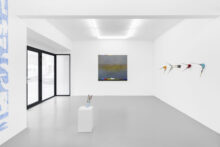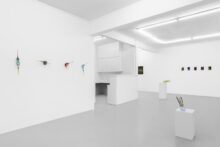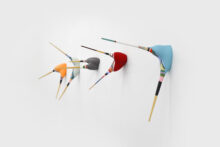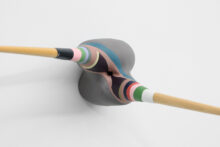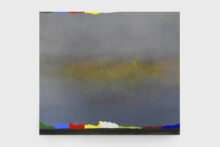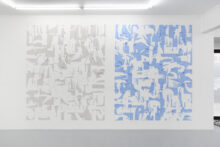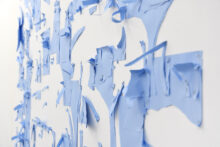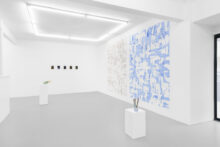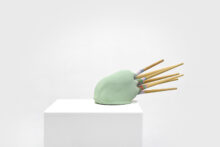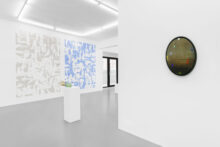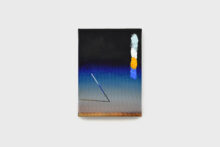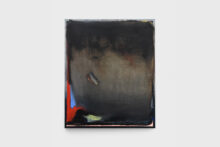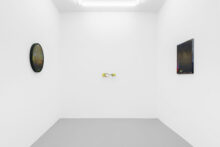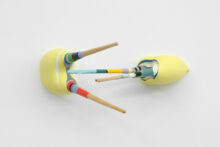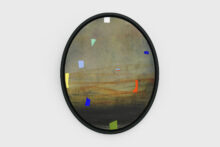Guillermo Mora
Adelheid De Witte
« The animals painted on the walls of Lascaux are not there in the same way as the fissures and limestone formations. But they are not elsewhere. Pushed forward here, held back there, held up by the wall’s mass they use so adroitly, they spread around the wall without ever breaking from their elusive moorings in it. I would be at great pains to say where is the painting I am looking at. For I do not look at it as I do at a thing; I do not fix it in its place. » – Maurice Merleau-Ponty, L’Oeil et l’Esprit, 1960
In the practice of Guillermo Mora and Adelheid De Witte, painting oscillates between various states of being and materializes in diverse ways. Their works exist in a precarious equilibrium, traversed by contrary forces. They add, conceal, tear away, erase before adding again, in a constant tension between what is thought of and what is not, between the slow construction of a composition and the impulse of a gesture.
The hybrid works of Spanish artist Guillermo Mora, characterized by transgression and subversion, challenge the limits of the pictorial discipline. Although he uses the language of painting, his processes of adding and removing matter are those of a sculptor. Elements that are usually invisible or purely functional – such as the paintbrushes used in the studio and staples that hold the canvas to the frame – suddenly appear at the forefront. The mural series “Si Pero No”, made of sheets of paper stapled and then ripped apart, perfectly illustrates this hierarchical reversal. The colored sheets are fixed directly to the wall by hundreds of staples, creating a monochrome surface – and thus an abstract painting – that the artist irreverently deconstructs. Far from elitism, the materials are within everyone’s reach and the gestures are simple and spontaneous. The geometrical structure of the overlapping papers, which gradually overtake their environment, is counterbalanced by the intense physical energy of each movement contained the composition.
Exploring another approach to stratification, the works “Uno y dos caminos”, “Camino de vuelta” and “Regreso y cruce” are paintbrushes swallowed by successive layers of paint that dry around their extremities and imprison them. Each piece takes shape over several months, in a long process of metamorphosis through which the paintbrush loses its primary function, becomes almost unrecognizable and transforms into a structural element of the work. According to Guillermo Mora, it is as if the imprints, traces, and gestures of a painting had to overcome and devour the objects that created it. The result is compact, physical, and visceral. A pervasive shape of pictorial matter in full mutation.
The works of Belgian painter Adelheid De Witte also exist in a state of tension between control and spontaneity, a balance between concealing and unveiling. Her compositions are often characterized by the unsettling incursion of geometric objects and abstract swathes of color that settle in vaporous settings or vague evocations of landscapes. Differing perspectives coexist and various light sources permeate the composition, as if the painting resulted from a collision of fragmented perceptions. In her recent works, the density of the brushstrokes complements the illusion of depth. Instead of being clearly delineated, the surfaces are barely sketched out. Their unfinished contours overlap and gradually give way to other spaces. The works “You’ll also need Sandpaper” or “What would You do?” testify of the artist’s experiments with the materiality and corporeality of painting.
Each work is slowly constructed, layer after layer, day after day. In her studio, Adelheid De Witte simultaneously works on several canvases and brings new gestures, techniques, impulses and intensities every day. She builds up an area of the work, adds matter before wiping it away, leaving a trace of what had appeared, then reconsiders the gesture and paints it over again. The issue of what should be hidden or unveiled is omnipresent. Some layers disappear completely, while others are revealed by openings in the composition. The sense of time is distended and fluctuating, weeks of meticulous work can suddenly give way to a quick and impulsive gesture when, in a pure moment of adrenaline, the artist lets her hand freely deposit a lump of paint on the canvas.
Uncertainty is a fundamental element in both artists’ practice. Through their work, Guillermo Mora and Adelheid De Witte move back and forth between control and impulsiveness, between rigorous mental constructions and the unrestrained expression of a gesture. The resulting pieces lie at the intersection of these tensions, these paradoxes that define the embodied existence of a work of art.
Maurice Merleau-Ponty, whose quote opens the text, has conceptualized this duality in L’Oeil et l’Esprit. Instead of providing an answer to the long-standing debate of the predominance of senses or thought, of the physical reality or the essence of ideas, the French philosopher reconciles these two concepts. For him, works of art concurrently represent “the inside of the outside and the outside of the inside”: a back-and-forth motion, a constant flux, in which painting is neither entirely anchored in reality nor pure thought – it is in-between these two states and both at the same time. The world is not made of clearly defined elements, standing separately from one another. On the contrary, objects and spaces overlap, interact, and influence each other in a condition he calls “intertwining”.
The works of Guillermo Mora and Adelheid De Witte are similarly composed of a succession of erasures and superimpositions, layers that are inextricably linked in our perception. As all things, they can only be understood in depth, through each other, and will always retain an element of mystery.
– Amélie Bataille
Opening Thursday 29.02, 5pm – 9pm
Exhibition until Saturday 13.04
Location
Irène Laub gallery
29 rue Van Eyck
1050 Brussels (BE)
Read more about Spanish artist Guillermo Mora and Belgian artist Adelheid De Witte

